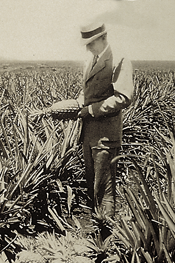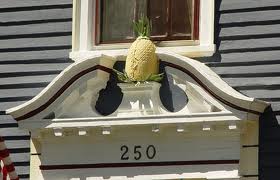Ananas comosus, the pineapple, is a plant that grows well in the greenhouse. Over the past few years we have successfully grown pineapple fruits along with our other Bromeliad family plants. There are so many fun facts to share with you about pineapples that I hardly know where to begin!
Native to southern Brazil and Paraguay, where its wild relatives occur, the pineapple was apparently domesticated by the indigenous people there and carried by them up through South and Central America to Mexico and the West Indies long before the arrival of Europeans. The first European account of the pineapple was given by Christopher Columbus and his company, who landed on the island now known as Guadeloupe on their second voyage of discovery. Columbus brought the succulent fruit back to Europe in 1493. Its cylindrical shape and rough, spiky surface caused the Spaniards to name it pina, after the pine cone. The English noted the same resemblance, resulting in our name “pineapple”.
Over the centuries, explorers carried pineapples and pineapple plants all over the world. They thrived in many tropical climates, perhaps most famously in Hawaii. Captain John Kidwell is most often credited with founding Hawaii’s pineapple industry. He began crop development trials in 1885 when he planted pineapple on the island of Oahu. It was, however, James Drummond Dole who is remembered for advancing the industry in Hawaii. In 1900 Dole purchased 61 acres in Oahu and began experimenting with pineapple. He incorporated the Hawaiian Pineapple Company in 1901 and began commercial growing. Dole was known as Hawaii’s “Pineapple King”, and the brand name Dole is synonymous with pineapple. But today, Hawaii’s pineapple production does not even rank within the top ten of the world’s pineapple producers. Worldwide, the top producers are Thailand (13%), the Philippines (11%) and Brazil (10%). Hawaii produces only about two percent of the world’s pineapple.
Ananas comosus is a tropical plant limited (except in greenhouses) to low elevations between 30°N and 25°S. A temperature range of 65°- 95°F is most favorable. Ideal rainfall is about 45 inches per year, half in the spring and half in the fall; though the pineapple is drought tolerant and will produce fruit under yearly precipitation rates ranging from 25 to 150(!) inches, depending on cultivar and location. They will grow well in full sun to light partial shade. The best soil for pineapple culture is a rich, well-drained, sandy loam. In the greenhouse they grow well in potting soil but do not like to be overwatered!
 A herbaceous perennial, the pineapple grows 3.5 to 5.0 ft tall. It produces many flowers at once, up to 200 at a time. Once it flowers, the individual fruits of the flowers join together to create a cone-shaped, compound, juicy, fleshy fruit — the pineapple. They can be propagated by planting the “crown” (the leafy top) of the fruit, or by planting the suckers which emerge from the sides and roots of the plant.
A herbaceous perennial, the pineapple grows 3.5 to 5.0 ft tall. It produces many flowers at once, up to 200 at a time. Once it flowers, the individual fruits of the flowers join together to create a cone-shaped, compound, juicy, fleshy fruit — the pineapple. They can be propagated by planting the “crown” (the leafy top) of the fruit, or by planting the suckers which emerge from the sides and roots of the plant.
To the Carib native people, the pineapple symbolized hospitality, and the Spaniards soon learned they were welcome if a pineapple was placed by the entrance to a village. This symbolism of hospitality spread to Europe and eventually through colonial North America. The English colonies on the East Coast were a land of small, primitive towns and settlements where homes served as the hubs of most community activity. Visiting was the primary means of entertainment and information exchange. The concept of hospitality was a central element of the society’s daily life. Seafaring captains used to impale fresh pineapples–souvenirs of their travels to tropical ports–atop the porch railings of their homes when they returned. It was a sign that the captain and his family were home and would welcome visitors.
This symbol of friendship and hospitality also became a favorite motif of architects, artisans and craftsmen throughout the colonies.The pineapple was seen painted on the front doors of homes, carved in finials atop gate-posts, entrance and porch columns, roof-tops, door lintels, bedposts and head-boards. Copper and brass pineapples were prominent in the weather vanes of public buildings. Pineapples were stenciled on walls and canvas mats. There were pineapples carved of wood, painted on fine china, and painted on the backs of chairs and tops of chests. Colonial needle-workers used the pineapple image for cross-stitch samplers, tablecloths, napkins, carpets, draperies, and crochet doilies.
If you visit the greenhouse, you will see a dwarf ornamental pineapple is just inside the Conservatory door to welcome you! Amid the food crop plants in greenhouse 113 and 111 you’ll find our full size plants with fruit. Although the flavor is not the same as pineapples grown outside in tropical fresh air and sunshine, the fragrance is incomparable! It fills the greenhouse as they ripen and makes my mouth water.









I’ve been watching the Victorian Kitchen Garden and those were SO prized the gardner was supposed to check the base of each Pineapple plant every day with a magnifying glass (per Mr. Beaton’s Request) for bugs… LOL could you imagine!
Oh YES I can imagine…perhaps a post in the future about scouting the greenhouses with a hand lens looking for insects every week…thanks for reading, Jasmine!
Really nice story of the pineapple Gabrielle! Happy Holidays to you and yours, and thanks again and always for all you do for the URI Botanical Gardens.
Thank you and Happy Holidays to you too!